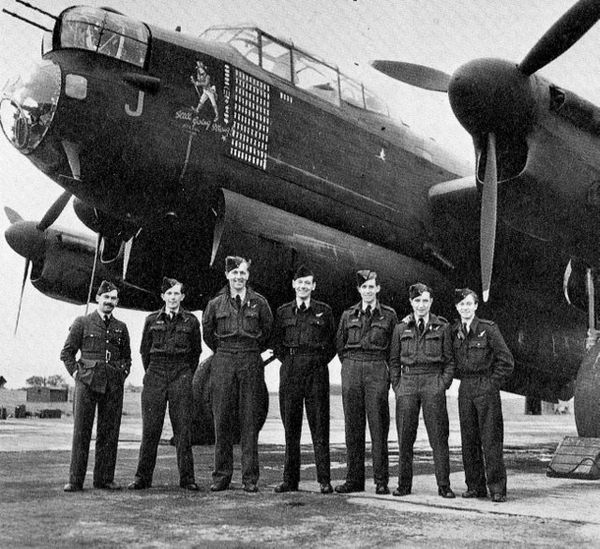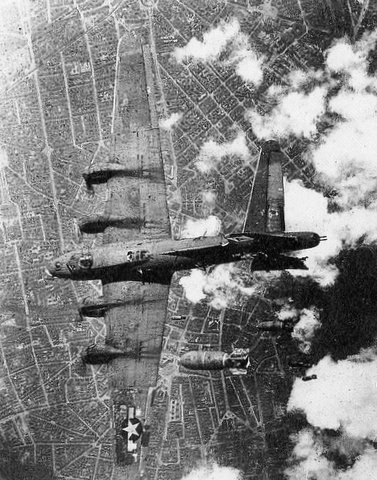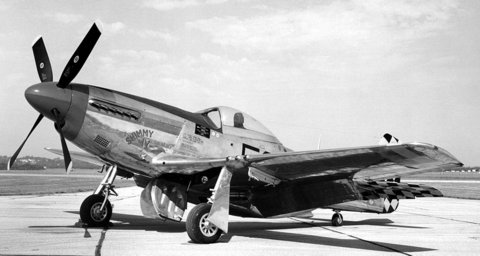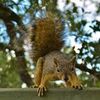Check out The Dynamics of Photographic Lighting section of our forum.
Preparing Berlin for the Russians - 1944-1945
Nov 5, 2014 18:12:26 #
Early in WW II, Hitler's Luftwaffe Field Marshal, Hermann Goering, famously boasted: "You can call me Meyer if the Allies ever bomb Berlin." The first British bombs fell on the German capital in the night of Aug. 25/26, 1940. Between 1941 and May, 1945, according to British historian Robin Cross, every ton of Nazi bombs dropped on Britain was matched by 315 tons dropped on German cities and industries.
On Nov. 3, 1943, Sir Arthur Harris, head of the Bomber Command, met with Prime Minister Winston Churchill to plead his case for "carpet bombing" Berlin: "We can wreck Berlin from end to end if the U.S. Army Air Force will come in on it. It will cost us between 400 and 500 planes. It will cost Germany the war."
"Bomber" Harris wanted night raids. The U.S. Eighth Air Force preferred daytime raids. On Nov. 18, the RAF began a series of 16 night raids on Berlin, dispatching 440 Lancaster bombers on the first attack (398 made it to Berlin and back, about 1,200 miles round trip). Berlin was a tough target. Of the 2,659 planes sent out during the first six night raids, only 400 even saw the ground marker flares.
The city's defenses included some ingenious touches. A dummy city, nine miles long, was set up 15 miles from Berlin as a confusing decoy with searchlights, bomb flashes, fires, and false target identifiers. Another defense used Berlin's weather. The city burned coal so it was usually covered in winter by low smog clouds. A tactic called Mattscheibe ("Groundglass") involved shining searchlights into the clouds so they glowed, thus silhouetting the bomber streams above them so the Luftwaffe fighters could attack from the dark night sky. By January, 1944, the RAF was losing 6.1 percent of its Berlin bombers. They had no fighter escorts.
In late Feb., 1944, Harris reassigned his bombers and the Americans took over. The first daytime raid on Berlin by the U.S. involved 31 unescorted B-17s, attacking on March 4th. The next attack, the first major American raid on metropolitan Berlin, took place on March 6th with 672 unescorted B-17s. They lost 75 bombers. On March 8th they returned to Berlin with 623 bombers escorted by 891 P-51D Mustang fighters. Luftwaffe pilot General Adolf Galland, who survived the war, later wrote: "Whenever our fighters appeared, the Americans hurled themselves at them. Nowhere were we safe from them."
Before the war ended in May, 1945, the Eighth Army Air Force hit Berlin twice more. On Feb. 3, 1945, a raid with over 1,200 bombers and 900 fighters dropped 2,466 tons on the German capital. The final -- and heaviest -- Berlin raid took place on March 18th. As the Red Army neared Berlin, 1,250 bombers were escorted by 670 fighters to prepare the city for its takeover by 2-1/2 million Russian troops.
On Nov. 3, 1943, Sir Arthur Harris, head of the Bomber Command, met with Prime Minister Winston Churchill to plead his case for "carpet bombing" Berlin: "We can wreck Berlin from end to end if the U.S. Army Air Force will come in on it. It will cost us between 400 and 500 planes. It will cost Germany the war."
"Bomber" Harris wanted night raids. The U.S. Eighth Air Force preferred daytime raids. On Nov. 18, the RAF began a series of 16 night raids on Berlin, dispatching 440 Lancaster bombers on the first attack (398 made it to Berlin and back, about 1,200 miles round trip). Berlin was a tough target. Of the 2,659 planes sent out during the first six night raids, only 400 even saw the ground marker flares.
The city's defenses included some ingenious touches. A dummy city, nine miles long, was set up 15 miles from Berlin as a confusing decoy with searchlights, bomb flashes, fires, and false target identifiers. Another defense used Berlin's weather. The city burned coal so it was usually covered in winter by low smog clouds. A tactic called Mattscheibe ("Groundglass") involved shining searchlights into the clouds so they glowed, thus silhouetting the bomber streams above them so the Luftwaffe fighters could attack from the dark night sky. By January, 1944, the RAF was losing 6.1 percent of its Berlin bombers. They had no fighter escorts.
In late Feb., 1944, Harris reassigned his bombers and the Americans took over. The first daytime raid on Berlin by the U.S. involved 31 unescorted B-17s, attacking on March 4th. The next attack, the first major American raid on metropolitan Berlin, took place on March 6th with 672 unescorted B-17s. They lost 75 bombers. On March 8th they returned to Berlin with 623 bombers escorted by 891 P-51D Mustang fighters. Luftwaffe pilot General Adolf Galland, who survived the war, later wrote: "Whenever our fighters appeared, the Americans hurled themselves at them. Nowhere were we safe from them."
Before the war ended in May, 1945, the Eighth Army Air Force hit Berlin twice more. On Feb. 3, 1945, a raid with over 1,200 bombers and 900 fighters dropped 2,466 tons on the German capital. The final -- and heaviest -- Berlin raid took place on March 18th. As the Red Army neared Berlin, 1,250 bombers were escorted by 670 fighters to prepare the city for its takeover by 2-1/2 million Russian troops.
An RAF Lancaster bomber crew celebrate its 100th mission - 1945

A doomed B-17 bomber over Berlin was crippled by bombs from a higher bomber - 1944

Long-range U.S. P-51D Mustang fighters changed bomber losses - 1944-45

Nov 5, 2014 18:18:20 #
Nov 5, 2014 18:59:23 #
Jay Pat wrote:
Great, informative post!
Thanks, Pat
Thanks, Pat
Thank you for your comments, Pat. I felt this was a story that's been neglected.
Check out Video for DSLR and Point and Shoot Cameras section of our forum.
Nov 5, 2014 20:21:16 #
Thank you very much. I have enjoyed all your WWII posts and hope you many more to share. :thumbup: :thumbup: :thumbup:
Nov 5, 2014 20:37:09 #
jederick wrote:
Thank you very much. I have enjoyed all your WWII posts and hope you many more to share. :thumbup: :thumbup: :thumbup:
Nice to hear from you, jederick. Thanks for your comments. I'm afraid I have more stories than I have time to describe them, but who knows?
Nov 6, 2014 07:25:56 #
Nov 6, 2014 07:40:29 #
richosob
Loc: Lambertville, MI
Thanks again for the history lesson. Love to read your posts hope to see many more.
Rich
Rich
Check out Landscape Photography section of our forum.
Nov 6, 2014 07:50:22 #
Much enjoyed the info and images. A moment of thanks for all the Allied airmen who selflessly gave their lives to help bring the Nazi tyranny down.
Nov 6, 2014 07:54:46 #
Very interesting story, brought to you by "The Greatest Generation."
Nov 6, 2014 08:05:44 #
Great post have read a lot about both world wars. I was only 6 when WWII started , We lived in the country and had no working radio [sometimes] and still remember my granddad coming to our house and telling Dad and Mother about Pearl Harbor on that Sunday morning. Being 6, I did not understand what was happening but do remember the very worried look on dad and mom face Those images are still very vivid.
Nov 6, 2014 08:27:32 #
user47602
Loc: ip 304.0.0.33.32
richard, you really make that time come alive... you need to write a book! ..or at least start a blog.
thanks
thanks
Check out Smartphone Photography section of our forum.
Nov 6, 2014 08:45:47 #
Ron Schulz
Loc: Colorado
More fascinating WWII history. I knew Berlin was heavily bombed but not to that extent. I also did not know about the decoy city. Now I've get to do some more research.
Thanks so much for the post..
Thanks so much for the post..
Nov 6, 2014 08:50:11 #
I relly enjoy your posts about WWII and post-war Germany. I visited Berlin, both east and west, in 1960. The devastation from the war was still quite evident in the Russian Sector.
Nov 6, 2014 09:17:14 #
RichardQ wrote:
Early in WW II, Hitler's i Luftwaffe /i Field Ma... (show quote)
Thank you for posting this.
Nov 6, 2014 09:33:12 #
As a RAF Bomber Command pilot I bombed Berlin but in the end it got too hot for us with huge losses. It was too far for fighter escort not that we had it at night.However other major cities were devastated by RAF and US bombing.Of course the RAF were bombing long before the US entered the fray and sor a considerable time was the only UK forces fighting back.
If you want to reply, then register here. Registration is free and your account is created instantly, so you can post right away.
Check out The Dynamics of Photographic Lighting section of our forum.








